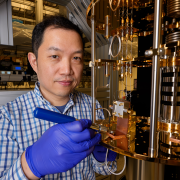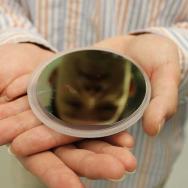From punch card-operated looms in the 1800s to modern cellphones, if an object has “on” and “off” states, it can be used to store information.
In a laptop computer, the ones and zeroes that make up the binary language are actually transistors either running at low or high voltage. On a compact disc, the one is a spot where a tiny indented “pit” turns to a flat “land” or vice versa, while a zero represents no change.
Historically, the size of the object cycling through those states has put a limit on the size of the storage device. But now, researchers from the University of Chicago Pritzker School of Molecular Engineering have explored a technique to make the metaphorical ones and zeroes out of crystal defects, each the size of an individual atom, for classical computer memory applications.
The innovation uses quantum techniques in an interdisciplinary way to revolutionize classical, non-quantum computers. The team’s research was published in the journal Nanophotonics.
“Each memory cell is a single missing atom—a single defect,” said UChicago PME Asst. Prof. Tian Zhong. “Now you can pack terabytes of bits within a small cube of material that's only a millimeter in size.”
The findings are rooted in the Ph.D. research of first author Leonardo França, a postdoctoral researcher in Zhong’s lab, while he was at the University of São Paulo in Brazil. He was then studying radiation dosimeters, devices commonly used to measure and record radiation levels to protect hospital employees working with X-ray machines.
“In the hospitals and in particle accelerators, for instance, [they’re] needed to monitor how much of a radiation dose people are exposed to,” said França. “There are some materials that have this ability to absorb radiation and store that information for a certain amount of time.”
He soon became fascinated about how through optical techniques—shining a light—he could manipulate and “read” that information.
“When the crystal absorbs sufficient energy, it releases electrons and holes. And these charges are captured by the defects,” França said. “We can read that information. You can release the electrons, and we can read the information by optical means.”
França soon saw the potential for memory storage and brought this non-quantum work into Zhong’s quantum laboratory. The result is a groundbreaking take on classical memory storage.
“We're creating a new type of microelectronic device, a quantum-inspired technology,” Zhong said.
Rare earth
To create the new memory storage technique, the team added ions of “rare earth,” a group of elements also known as lanthanides, to an oxide crystal.
They chose rare earths due to their powerful, flexible optical properties.
“It’s well known that rare earths present specific electronic transitions that allow you to choose specific laser excitation wavelengths for optical control, from [ultraviolet] up to near-infrared regimes,” França said.
Unlike dosimeters, which are typically activated by X-rays or gamma rays, here the storage device is activated by a simple ultraviolet laser. The laser stimulates the rare earth ions, which in turn release electrons. The electrons are trapped by some of the oxide crystal’s defects, such as individual gaps in the structure where a single oxygen atom should be, but isn’t.
“It’s impossible to find crystals—in nature or artificial crystals—that don't have defects,” França said. “So what we are doing is we are taking advantage of these defects.”
While these crystal defects are often used in quantum research, entangled to create “qubits” in gems from stretched diamond to spinel, the UChicago PME team found another use. They were able to guide when defects were charged and when they weren’t.
By designating a charged gap as “one” and an uncharged gap as “zero,” they were able to turn the crystal into a powerful memory storage device on a scale unseen in classical computing.
“Within that millimeter cube, we demonstrated there are about at least a billion of these memories—classical memories, traditional memories—based on atoms,” Zhong said.
Citation: “All-optical control of charge-trapping defects in rare-earth doped oxides,” França et al, Nanophotonics, February 14, 2025. DOI: 10.1515/nanoph-2024-0635
Funding: This work was supported by the U.S. Department of Energy, Office of Science, for support of microelectronics research, under Contract No. DE-AC0206CH11357

